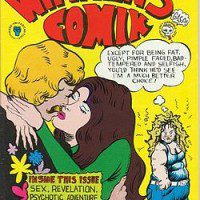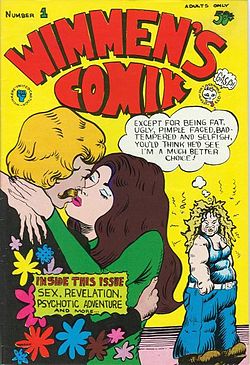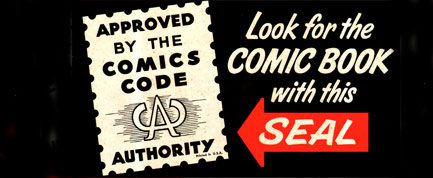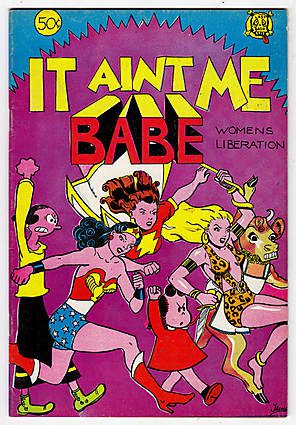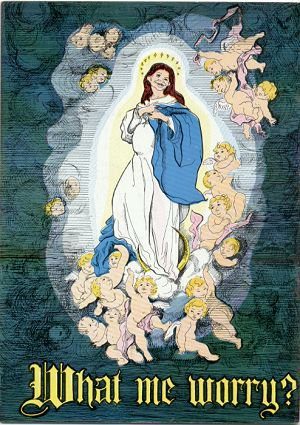The New York Comics & Picture-Story Symposium is a weekly forum for discussing the tradition and future of text/image work. Open to the public, it meets Monday nights 7-9pm EST in New York City. Presentations vary weekly and include everything from historical topics and technical demonstrations to creators presenting their work. Check out upcoming meetings here.
Open to the public, it meets Monday nights 7-9pm EST in New York City. Presentations vary weekly and include everything from historical topics and technical demonstrations to creators presenting their work. Check out upcoming meetings here.
Samantha Meier, Gender and Politics Editor for PolicyMic, spoke at the New York Comics and Picture-Story Symposium this week, giving a talk entitled “Women’s Comix: Where Were the Gender Politics in Underground Comix?” Meier’s talk focused on the interrelations among underground comix, women artists, and second wave feminism from the 1960s to the 1990s, a subject she has studied since she began researching her senior thesis in Sociology at Harvard.
Wimmen’s Comix #1 “The Seduction of the Innocent”
Meier began with a history of the Comics Code Authority, the industry’s attempt at self-censorship following its condemnation by McCarthyites in the early 1950s. Comics had been suspected of encouraging juvenile delinquency since the 1940s, and continued to be so well into the 1950s, the period of their greatest sales. A series of editorials and papers written by the psychiatrist Fredric Wertham, which culminated in the 1954 publication of his book The Seduction of the Innocent, gave psychiatric license to public sentiments that had disapproved of the morality of comics. Public ordinances banning the sale of comics were subsequently passed by a variety of local communities, and occasionally even book burnings were staged, notably in Spencer, WV and Binghamton, NY. A Senate Subcommittee brought the debate to the national level, calling on Wertham to testify. Wertham’s suppositions included the idea that the relationship between Batman and Robin was “like a wish dream of two homosexuals living together.”
Comics Code Authority Seal
Although Wertham’s research methods have since been called into question, their combination with conservative public disapproval at the time led the comics industry to form the Comics Magazine Association of America, an attempt at a self-regulatory mechanism that guaranteed to parents the moral approvability of their products. This organization, which 28 of the major 31 comics publishers at the time joined, established a set of rules that needed to be followed in order to receive the “Comics Code Authority” stamp of approval. These rules included demands that no crime be represented positively or in sufficient detail that it could be imitated, that no lurid or gruesome illustrations be printed, that no obscenity or nudity be found in any issue, and that women not be drawn with “exaggerated” qualities. Publishers like EC Comics that did not comply soon went out of business, and a general downturn in comics sales followed despite the best intentions of the publishers who did. The Comics Code continued in effect until 2011, when the three last holdouts still to comply – DC Comics, Archie Comics, and Bongo Comics – all abandoned it.
“The Underground Develops”
Meier’s next subject was the effect the Comics Code had on younger, more rebellious artists in the 1960s. The new form comics took since the industry self-censored engendered in younger fans a sense of boredom, which led to the attempt to make newer forms based on unorthodox artistic models. Tijuana Bibles, a black market product that depicted trademark characters in sexual scenarios, underground newspapers, and college humor and satire magazines all became resources on which younger artists like Robert Crumb, Gilbert Sheldon, and Trina Robbins would draw. Many publishers switched tactics to avoid the Code, like Harvey Kurtzman, who changed his comic Tales to Drive You Mad to a magazine format with the new title Mad. New underground newspapers were published – the number jumping from five in 1965 to several hundred by 1968 – many of which featured strips by up and coming comic artists. Offset printing had made papers easy and cheap to produce, and the democratic spirit of the period led many publishers to make collective decisions, their staffs modeled on the format of the Discussion Bulletin of Students for a Democratic Society. In 1967, the Philadelphia-based paper Yarrowstalks commissioned an all comics issue from Robert Crumb. Due to a mishap, the publisher failed to print the issue, leaving Crumb with a series of pages. He decided instead to self-publish these as Zap Comics 0 (or 1, depending on how one counts issues) which he sold from a baby carriage after he moved to the Bay Area. Many artists would follow Crumb’s path out west, hoping to collaborate with him. New publishers like Print Mint and Last Gasp Eco Comix rose to aid the growing supply of young artists, and the Underground Comix movement was born. The community did not operate like the community for mainstream publications. Because underground comix flagrantly violated the Comics Code, they could not be sold on newsstands or in bookstores; instead, they were mainly sold in head shops.
“So This Is Where I Come In”
After recounting the history of the Underground Comix movement, Meier turned to the subject of her own research, women in the underground comix movement. Her senior thesis, which included an illustrated introduction, focused on the publication history of two anthologies: Wimmen’s Comix, which had a seventeen issue run from the early 1970s to the early 1990s (with a decade-long break in between), and Tits & Clits, a title with a shorter run of seven issues running semi-regularly from 1972 to 1983.
It Ain’t Me Babe
Meier had been dissatisfied with the types of history written about women comic artists and about the underground comix movement in general. Most histories of the underground comix movement are the works of fans or participants. Meier briefly described her methodology before proceeding to her description of the thesis. She spoke to twenty-three cartoonists associated with these titles, in addition to to comix publishers and cartoonists from the more general milieu of underground comix, conducting semi-structured interviews with artists about comics and politics. Her thesis explored the links among the underground comix scene, the counterculture of the late 1960s, the New Left, and second wave feminism.
“The Same Old Story”
Meier’s research regarding the earliest women of underground comix in the late ‘60s revealed pattern typically experienced by women trying to enter fields where men had a hegemonic position – marginalization and outright exclusion. Until 1970, only a handful of women created comics for underground newspapers. While many early women in underground comix responded to the sexist industry in their work, there existed no agreement amongst these artists regarding the ‘feminist’ characteristics of their work.
Among the artists, Trina Robbins did the most to popularize the story of women’s comix. Robbins’ path to comics was uneven. She began as a fashion designer in Laurel Canyon before doing her first comic for the Los Angeles Free Press. In 1966, she moved to the Lower East Side of Manhattan to sell bohemian clothing at a boutique called “Broccoli.” After being put in touch with the managing editor of the East Village Other (EVO), Eve Babitz, Robbins began drawing comic advertisements for EVO featuring a character named Suzy Slumgoddess. Without much financial success as an artist on the East Coast, in 1969 she returned to the west, this time settling in San Francisco to try to join the burgeoning underground comix movement.
Robbins’ successful entry into the underground comix world was indirect. After meeting with no success in her attempts to get into male-dominated anthologies, she began to do work for It Ain’t Me, Babe, one of many feminist underground newspapers which began to sprout up around the country in the early ‘70s. This was part of a growing trend of Feminist publications, some of which were more mainstream, others separatist. Robbins’ work on It Ain’t Me, Babe was successful enough to get the attention of other publishers who wanted to produce something like it.
Robbins contacted Meredith Kurtzman, daughter of Harvey Kurtzman, the publisher of Mad, hoping to draw her into the production of a comics anthology featuring women artists. She later was contacted by Ron Turner, a publisher who had bought It Ain’t Me, Babe, and wanted another. The founding mothers, who would receive Turner’s financial backing, met at the house of Patty Moodian in 1972 to discuss the production of what would eventually become Wimmen’s Comix. Later that year, Robbins and the others opened to submissions by mail, and organized the title with a rotating editorship. The first issue was 36 pages, 34 in black and white with color covers. Over the course of its run, Wimmen’s Comix was published by Last Gasp, then Renegade Press when it rebooted in 1987, and later by Rip Off Press until it folded. Ironically, Wimmen’s Comix met with resistance from the mainstream Feminist movement – when Robbins applied to advertise the title in Ms. Magazine, she was rejected by Gloria Steinem. However, the title did succeed in establishing the careers of many of the artists now at the center of high-quality comics art, including Alison Bechdel.
Before turning her presentation over to questions, Meier described the foundation of Tits & Clits, out of southern California. A more provocative title, featuring characters like “Abortion Eve” even before Roe v. Wade, Tits and Clits was produced by two Laguna-based artists, Lyn Chevli and Joyce Farmer, who had met through Fahrenheit 451, the bookstore Chevli ran in the Orange County town. The first issue was published out of Los Angeles, and distributed through a variety of unorthodox places, including abortion clinics. However, distribution through these places often failed. Tits and Clits published at a rate of about one issue per year, ending in the early 1980s, when the Women’s Comix movement began to experience severe changes. Some of these could be attributed to the general backlash against Feminism that characterized the rise of the Reagan Right, but the success of these titles also led partially to their demise – as they became more established, artists became less concerned with the simple exposure of women artists, and more concerned with producing work of high quality by women, and the artists also noticed that their political and artistic beliefs were not necessarily compatible with other women who considered themselves Feminist.
Joyce Farmer, “Abortion Eve,” back cover of an informational pamphlet produced by Farmer and Lyn Chevli
Meier ended her formal presentation with Tits and Clits, turning the discussion over to the audience for a Q & A.
***
Image Credits:
Patricia Moodian, Cover of Wimmen’s Comix #1, Nov. 1972
Comics Code Authority Seal, 1955-2010
Trina Robbins, It Ain’t Me Babe, July 1970
Joyce Farmer, Abortion Eve, 1975
Samantha Meier is Gender and Politics Editor for PolicyMic. You can read her two blogs at http://womenscomix.wordpress.com and http://sammeier.policymic.com
Evan Neely is Visiting Assistant Professor of Art History at Pratt Institute. You can reach him at eneely@pratt.edu
